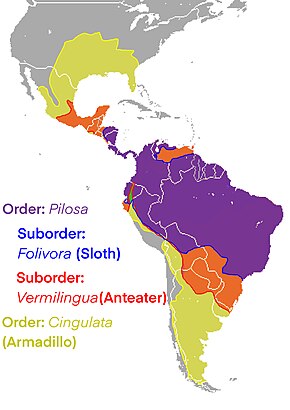
Back Xenarthra Afrikaans غريبات المفاصل Arabic غريبات المفاصل ARZ Xenarthra AST Kəmdişlilər Azerbaijani Няпоўназубыя BE-X-OLD Непълнозъби Bulgarian Xenarthra Breton Xenartres Catalan Xenarthra CEB
| Xenarthrans Temporal range: Late Paleocene –Recent,
| |
|---|---|

| |
| Scientific classification | |
| Domain: | Eukaryota |
| Kingdom: | Animalia |
| Phylum: | Chordata |
| Class: | Mammalia |
| Infraclass: | Placentalia |
| Superorder: | Xenarthra Cope, 1889 |
| Orders and suborders | |
| |

| |
| Red: anteater, yellow: armadillo, blue: sloth, orange: both anteater and armadillo, green: both armadillo and sloth, purple: anteater, armadillo and sloth | |
Xenarthra (/zɛˈnɑːrθrə/; from Ancient Greek ξένος, xénos, "foreign, alien" + ἄρθρον, árthron, "joint") is a major clade of placental mammals native to the Americas. There are 31 living species: the anteaters, tree sloths, and armadillos.[1] Extinct xenarthrans include the glyptodonts, pampatheres and ground sloths. Xenarthrans originated in South America during the late Paleocene about 60 million years ago.[2] They evolved and diversified extensively in South America during the continent's long period of isolation in the early to mid Cenozoic Era. They spread to the Antilles by the early Miocene and, starting about 3 million years ago, spread to Central and North America as part of the Great American Interchange.[3] Nearly all of the formerly abundant megafaunal xenarthrans became extinct at the end of the Pleistocene.
Xenarthrans share several characteristics that are not present in other placental mammals, which suggest that Xenarthrans descend from subterranean diggers. The name Xenarthra derives from the two ancient Greek words ξένος (xénos), meaning "strange, unusual", and ἄρθρον (árthron), meaning "joint",[4][5] and refers to their vertebral joints, which have extra articulations that are unlike other mammals. The ischium of the pelvis is also fused to the sacrum of the spine.[6] Xenarthran limb bones are typically robust, with large processes for muscle attachment. Relative to their body size, living xenarthrans are extremely strong.[7] Their limb bone structures are unusual. They have single-color vision. The teeth of Xenarthrans are unique. Xenarthrans are also often considered to be among the most primitive of placental mammals. Females show no clear distinction between the uterus and vagina, and males have testicles inside the body, which are located between the bladder and the rectum.[8] Xenarthrans have the lowest metabolic rates among therians.[9][10]
Xenarthran forms and lifestyles include:
- Armadillos: Mostly small and some larger omnivores and insectivores with flexible banded body armor
- Glyptodonts: Large herbivores with a rigid semi-spherical carapace
- Pampatheres: Large herbivores (and possibly omnivores) with banded body armor
- Anteaters: Small to large specialized feeders on social insects
- Tree sloths: Medium-sized folivores specialized for life hanging upside-down in trees
- Ground sloths: Medium to very large ground-living herbivores (and possibly omnivores)
- Aquatic sloths: Thalassocnus, a medium-sized herbivore, is the only known aquatic sloth
- ^ Vizcaíno, Sergio F.; Loughry, W. J., eds. (2008). The biology of the Xenarthra. Gainesville: University Press of Florida. ISBN 978-0-8130-3718-9. OCLC 741613153.
- ^ O'Leary, M. A.; Bloch, J. I.; Flynn, J. J.; Gaudin, T. J.; Giallombardo, A.; Giannini, N. P.; Cirranello, A. L. (2013). "The placental mammal ancestor and the post–K-Pg radiation of placentals". Science. 339 (6120): 662–667. Bibcode:2013Sci...339..662O. doi:10.1126/science.1229237. hdl:11336/7302. PMID 23393258. S2CID 206544776.
- ^ Woodburne, Michael O. (2010). "The Great American Biotic Interchange: Dispersals, Tectonics, Climate, Sea Level and Holding Pens". Journal of Mammalian Evolution. 17 (4): 245–264. doi:10.1007/s10914-010-9144-8. PMC 2987556. PMID 21125025.
- ^ Bailly, Anatole (1981-01-01). Abrégé du dictionnaire grec français. Paris: Hachette. ISBN 978-2010035289. OCLC 461974285.
- ^ Bailly, Anatole. "Greek-french dictionary online". www.tabularium.be. Retrieved May 2, 2020.
- ^ Delsuc, Frédéric; Catzteflis, François M.; Stanhope, Michael J.; Douzery, Emmanuel J. P. (August 2001). "The evolution of armadillos, anteaters and sloths depicted by nuclear and mitochondrial phylogenies: implications for the status of the enigmatic fossil Eurotamandua" (PDF). Proc. R. Soc. Lond. B. 268 (1476): 1605–15. doi:10.1098/rspb.2001.1702. PMC 1088784. PMID 11487408. Archived from the original (PDF) on 2016-03-04. Retrieved 2013-01-04.
- ^ Webb, S. David (2001). "Chapter 10: Mammalia 2: Xenarthrans". In Hulbert, Richard C. (ed.). The Fossil Vertebrates of Florida. University Press of Florida. p. 176. ISBN 0-8130-1822-6.
- ^ Kleisner, K; Ivell, R; Flegr, J (2010). "The evolutionary history of testicular externalization and the origin of the scrotum". Journal of Biosciences. 35 (1): 27–37. doi:10.1007/s12038-010-0005-7. PMID 20413907. S2CID 11962872.
- ^ Elgar, M. A.; Harvey, P. H. (1987). "Basal Metabolic Rates in Mammals: Allometry, Phylogeny and Ecology". Functional Ecology. 1 (1): 25–36. Bibcode:1987FuEco...1...25E. doi:10.2307/2389354. JSTOR 2389354.
- ^ Lovegrove, Barry G. (2000). "The Zoogeography of Mammalian Basal Metabolic Rate". The American Naturalist. 156 (2): 201–19. doi:10.1086/303383. JSTOR 3079219. PMID 10856202. S2CID 4436119.
© MMXXIII Rich X Search. We shall prevail. All rights reserved. Rich X Search